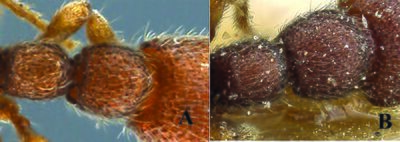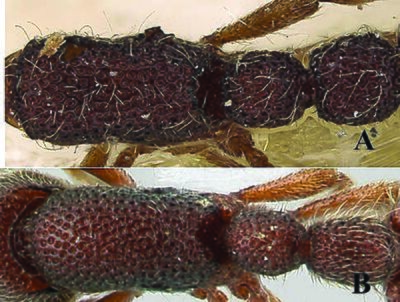Key to species of Ooceraea
There are two recent keys to workers of Ooceraea, the first by Zhou, Chen & Chen (2020) and a second by Bharti, Rilta & Dhadwal (2021).
Zhou, Chen & Chen (2020)
This key as been updated to include the species recently described by Bharti et al. (2021).
1
- Antenna 8-segmented (China: Guangxi) => Ooceraea octoantenna
- Antenna 9-segmented => 5
- Antenna 10-segmented => 13
- Antenna 11-segmented => 3
3
return to couplet #2
- Propodeum armed with two pairs of denticles (Vietnam) => Ooceraea quadridentata
- Propodeum armed without denticles => 4
4
return to couplet #3
- Anterior of pronotum with distinct ridge; pronotum in lateral view slightly convex dorsally; postpetiole in dorsal view slightly broader than long (Sri Lanka) => Ooceraea coeca
- Anterior of pronotum without ridge; pronotum in lateral view distinctly convex dorsally; postpetiole in dorsal view slightly longer than broad (Sri Lanka) => Ooceraea fragosa
5
return to couplet #2
- Compound eye present, comprising more than 10 ommatidia (India) => Ooceraea besucheti
- Compound eye absent or extremely vestigial => 6
6
return to couplet #5
- Postpetiole in dorsal view slightly longer than broad => 7
- Postpetiole in dorsal view slightly broader than long => 8
7
return to couplet #6
- Head coarsely and irregularly rugose and punctuate (Solomon Islands) => Ooceraea pawa
- Head only bearing regular punctures (New Guinea) => Ooceraea pusilla
8
return to couplet #6
- Dorsum of mesosoma smooth and shiny (australis) => Ooceraea australis
- Dorsum of mesosoma with abundant punctures => 9
9
return to couplet #8
- Diameter of punctures on dorsum of head as equal to or larger than the average distance separating them => 10
- Diameter of punctures on dorsum of head distinctly smaller than the average distance separating them => 12
10
return to couplet #9
- Posterior margin of head distinctly concave in the middle (India) => Ooceraea alii
- Posterior margin of head almost straight, at most shallowly concave => 11
11
return to couplet #10
- Antennal scrobe surface smooth and shiny (Fiji) => Ooceraea fuscior
- Antennal scrobe surface with annular fine striation (New Guinea) => Ooceraea papuana
12
return to couplet #9
- For full-face view the head is broader posteriorly (The tropical regions) => Ooceraea biroi
- For full-face view the head is as broad in front as behind (Fiji) => Ooceraea crypta
13
return to couplet #2
- Head as long as broad; eyes present; propodeal lobes reduced; petiolar node in lateral view hemiglobular; anteroventral part of subpetiolar process sickleshaped; head and body comparatively more pilose (India) (Fig. A, B) => Ooceraea joshii
- Head distinctly longer than broad; eyes absent; propodeal lobes roundly produced; petiole node in lateral view rectangular; anteroventral part of subpetiolar process forming a rectangular and semitransparent lobe (India) (Fig. C, D) => Ooceraea decamera
Bharti, Rilta & Dhadwal (2021)
Note: Comprehensive morphological diagnosis and image of Syscia guizhouensis is not available, so this species has been not included in the key. However, as cited in the comparative diagnosis, Syscia guizhouensis is close to Ooceraea besucheti and Ooceraea fragosa, but differs in having coarse pilose punctures on the surface of the mandibles, petiolar node distinctly longer than broad and is without eyes.
1
- Whole body variously sculptured => 2
- Whole body not sculptured, mesosoma smooth and shiny (Fig. A) => Ooceraea australis
2
return to couplet #1
3
return to couplet #2
- Anterolateral shoulders of the first gastric segment as seen from above broadly rounded and gradually widening caudad (Fig. A) => Ooceraea biroi
- Anterolateral shoulders of the first gastric segment abruptly rounded, accentuating the medium concavity that receives the postpetiole (Fig. B) => 4
4
return to couplet #3
- Postpetiole distinctly longer than broad (Fig. A) => 5
- Postpetiole broader than long (New Guinea) (Fig. B) => Ooceraea papuana
5
return to couplet #4
- Head coarsely and irregularly rugose and punctuate (Solomon Islands) => Ooceraea pawa
- Head regularly punctate (New Guinea) (Fig. A) => Ooceraea pusilla
6
return to couplet #2
- Lateral ridge of posterior face of propodeum armed with two pairs of denticles (Vietnam) (Fig. A) => Ooceraea quadridentata
- Lateral ridge of posterior face of propodeum without denticles (Fig. B) => 7
7
return to couplet #6
- Spaces between foveolae shagreen-like, giving the integument a rough appearance (Fig. A) => 8
- Spaces between foveolae smooth, giving the integument a shiny appearance (Fig. B) => 10
8
return to couplet #7
- Species large in size (HW> 70mm); posterior margin of head almost straight (Fig. A) => 9
- Species small in size (HW< 40 mm); posterior margin of head distinctly concave in the middle (Fig. B) => Ooceraea alii
9
return to couplet #8
- Sides of propodeum and sides of petiole with dense, deeply impressed foveae that are discernibly wider in diameter than propodeal spiracle or foveae on head. Dark species (Fiji) (Fig. A) => Ooceraea fuscior
- Sides of propodeum and sides of petiole with sparse, lightly impressed foveae that are not discernibly wider in diameter than propodeal spiracle or foveae on head. Pale species (Fiji) (Fig. B) => Ooceraea crypta
10
return to couplet #7
- Antenna 8-segmented (China) => Ooceraea octoantenna
- Antenna more than 8-segmented => 11
11
return to couplet #10
12
return to couplet #11
- Head as long as broad; eyes present; propodeal lobes reduced; petiolar node in lateral view hemiglobular; anteroventral part of subpetiolar process sickleshaped; head and body comparatively more pilose (India) (Fig. A, B) => Ooceraea joshii
- Head distinctly longer than broad; eyes absent; propodeal lobes roundly produced; petiole node in lateral view rectangular; anteroventral part of subpetiolar process forming a rectangular and semitransparent lobe (India) (Fig. C, D) => Ooceraea decamera
13
return to couplet #11
- Body shallowly and coarsely foveolate; eye present with multiple ommatidia (India) (Fig. A) => Ooceraea besucheti
- Body conspicuously foveolate; eye absent or vestigial (Fig. B) => 14
14
return to couplet #13
- Anterior portion of pronotum with distinct ridge; petiole and postpetiole in dorsal view broader than long (Sri Lanka) (Fig. A) => Ooceraea coeca
- Anterior portion of pronotum without distinct ridge; petiole and postpetiole in dorsal view longer than broad (Sri Lanka) (Fig. B) => Ooceraea fragosa
References
- Bharti, H., Rilta, J.S., Dhadwal, T. 2021. Two new species of Ooceraea (Hymenoptera, Formicidae, Dorylinae) from India with ten-segmented antennae. ZooKeys 1010, 165–183 (doi:10.3897/zookeys.1010.58436).
- Zhou, S.Y., Chen, D.N., Chen, Z.L. 2020. Discovery of novel Ooceraea (Hymenoptera: Formicidae: Dorylinae) species with 8-segmented antennae from China. Sociobiology 67, 139-143 (doi:10.13102/sociobiology.v67i2.3740).











